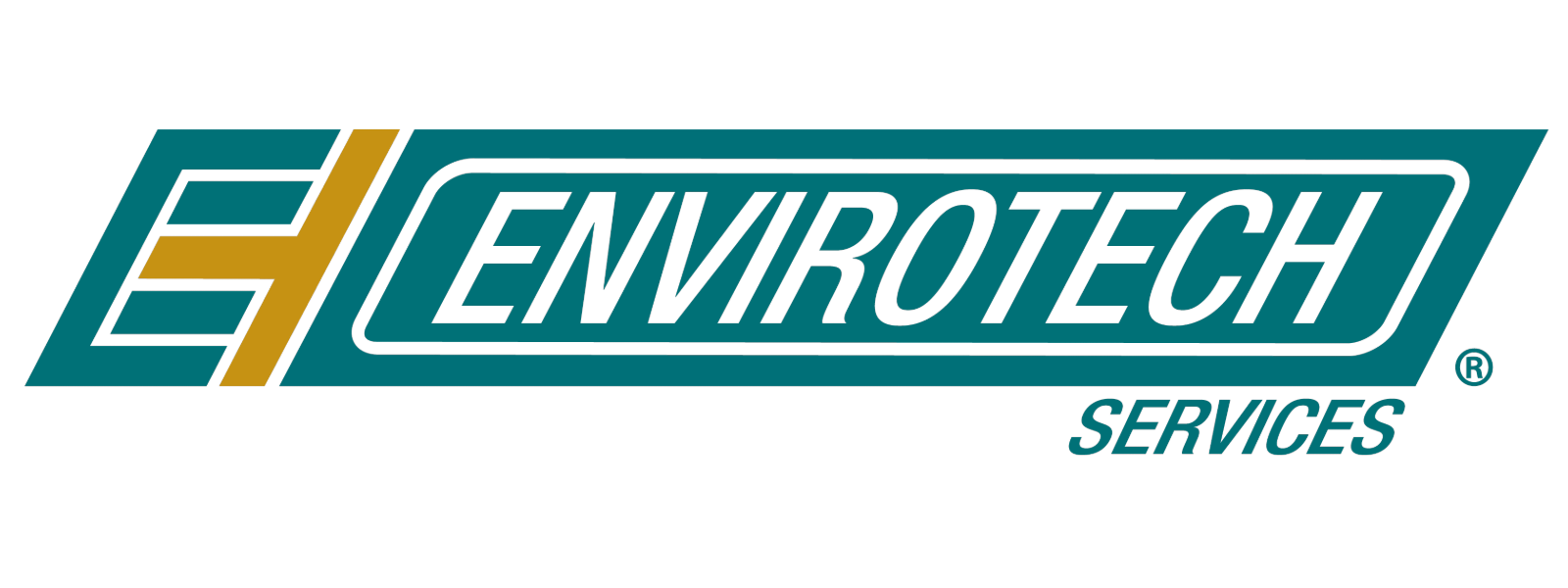No standard exists for determining when snow and ice accumulation is severe enough that it will endanger patrons or employees. In most cases, managers and supervisors must use their own judgment to alter work practices based on changes in weather conditions. Just plowing or shoveling snow cannot prevent slippery conditions for pedestrians, 90% of walkway injuries happen with less than 1 inch of snow. Just a thin layer of snow is all it takes to make the difference between a sidewalk with traction and a slippery mess. If sidewalks are not cleared properly, liability falls on the property owner. Facility managers need to understand anti-icing and de-icing technologies and the relative best practices to employ. To protect yourself from slip-and-fall lawsuits, you can:
- Monitor the slip factor by checking walkways yourself.
- Put up signs. If you know that a certain section of your walkway or parking lot is prone to ice formation, put up a sign that warns patrons or employees of the possible slip factor.
- Use best practices in terms of fundamental snow and ice control strategies.
The fundamental snow and ice control strategies in winter maintenance include: Anti-icing, Deicing, Pre-wetting, and Pretreating.
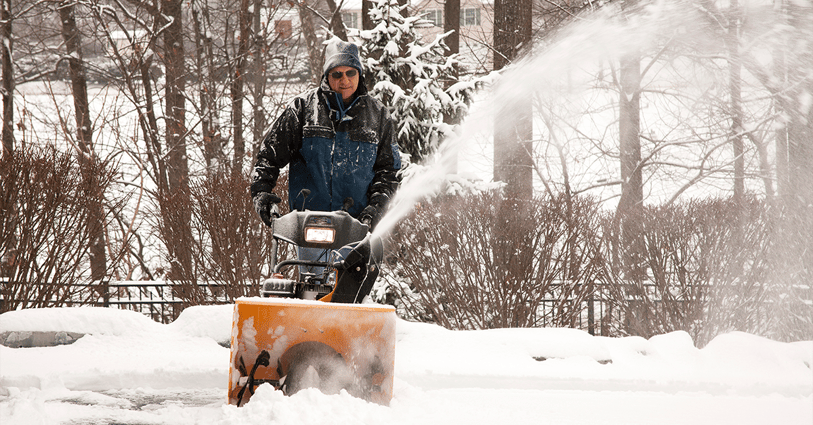
Anti-icing
|
Anti-icing is the best technique for applying salt to prevent the bonding of snow and ice to surfaces that include sidewalks, parking lots and roadways. This method is preferred because it is a proactive, bottom-up approach to preventing snow and ice compaction on surfaces in order to provide safe walking and driving conditions. One common misconception with this practice is that performing anti-icing before a storm in addition to de-icing after a storm will use more salt and cost more money. In fact, studies have proven that anti-icing reduces salt use because less and sometimes no salt is required after the storm. Because it prevents the bonding of snow and ice, it reduces the risk of slip and fall liability. |
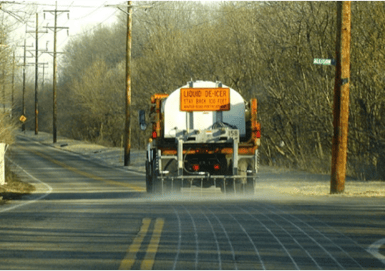 |
Anti-icing is the most cost-effective and environmentally safe practice in winter maintenance. Anti-icing requires about ¼ the material and 1/10 the overall cost of deicing. It can increase safety, and is effective and cost-efficient when correctly used and approached with realistic expectations. EnviroTech offers MeltDown APEX®, a corrosion inhibited magnesium chloride liquid that can be used as pretreatment before the snow arrives. MeltDown Apex has an added corrosion inhibiting additive as well as Magnesium Chloride liquid works at lower surface temperatures than Salt Brine. EnviroTech also offers BetterBrine Powered by AMP® if you want a corrosion inhibited salt brine.
Additional Benefits of Anti-icing Include:
- Anti-icing can also prevent the formation of frost.
- It can be effective for up to several days depending on the weather conditions.
- Anti-icing is quick, it is possible to treat a parking lot in a matter of minutes.
Knowing surface temperature is a critical first step in determining what is appropriate to do and, if so, when. Depending on the time, not all surfaces can be treated the same, and not all surfaces will have the same temperature. Do not apply CaCl2 or MgCl2 to a warm surface (above 35º F pavement temperature). Surfaces can become “greasy” as CaCl2 and MgCl2 pulls moisture to the pavement. These liquids do not always become greasy, but there is a higher potential in warmer temperatures and higher humidity. Salt Brine (NaCl) does not become greasy, so when surface temperature indicates it is often a good choice. Do not apply liquids before it rains as liquid anti-icers will wash away. Spray the traffic lanes and the liquid will migrate with the tires to the parking areas, as liquids are dispersed by the traffic.
A hand held pump sprayer or backpack sprayer can be used for sidewalks. Remember to leave a pattern of wet and dry to reduce the chance of creating slippery conditions. There are many ways to retrofit a pick-up truck or ATV with a tank and one of the following boom, spray bar, or hose reel with sprayer. For applications with Salt Brine, we suggest using AMP® a corrosion inhibitor and performance additive. AMP® is an easy to use Salt Brine Additive that alows the Brine exhibit more tackyness thus ensuring it stays where it is sprayed, reduced corrosion by at 70% when compared to rock salt, and allows the Salt Brine to operate at lower temperatures.
Deicing
|
By contrast, de-icing is the technique for applying salt to remove accumulated ice or compacted snow already on surfaces. Although de-icing is the most common technique used after a storm, a best practice for salt efficiency is to perform de-icing to complement anti-icing and snow removal techniques. Deicing is the “traditional” approach to winter maintenance. Deicing is a reactive operation where a deicer is applied to the top of an accumulation of snow, ice, or frost that has already bonded to the pavement surface and can no longer be physically removed. Deicing costs more than anti-icing in materials, time, and equipment. Removing ice that has already bonded to the pavement is difficult and removing it mechanically can damage equipment and surfaces. Generally, enough ice must be melted chemically to break the bond between the ice and the pavement. This requires larger amounts of chemical, making deicing much less efficient than anti-icing. Apply just enough to loosen the bond between the pavement surface and the snowpack so it can be plowed off. |
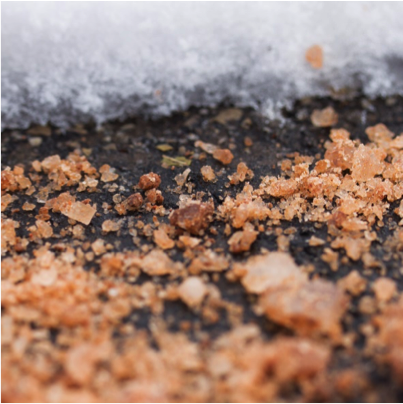 |
Ice Slicer® is a very effective deicer and can be used as solid anti-icer. Ice Slicer effectiveness comes from its natural formation in the Mountains of Utah that lead to a complex chloride with Sodium, Magnesium, Calcium and Potassium with clay and other inserts built into the structure of the molecule. It performs like no other mined salt, it has limited bounce and it works at colder temperatures. Ice Slicer is available across the country in bulk and bags. Nature’s Best and Ice Slicer Clear are additional offerings for the deicing market and available as packaged (bags) products nationwide.
Pre-wetting and Pretreating Salt and Sand
|
Pre-wetting and pretreating both mean getting dry material wet. Salt only melts snow and ice when it is in solution (dissolved). Dry salt does nothing until it is dissolved. Liquids applied to dry salt jump-start the melting process and penetrate ice and snow pack faster. SOS™ is a product offered by EnviroTech that at lower application rate, allows for significant benefits of treated salt. The product has been engineered to stay on the grains of Salt thereby providing wetting. Wet materials stick to the pavement and are less likely to end up in the nearby vegetation. |
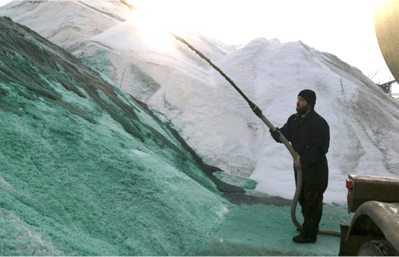 |
When integrating the liquids, decrease the application rate of the granular product. This is a common mistake made by new users of liquids. Pretreatment (at the spinner treatment) is the process of adding liquid to solids as they are applied to the pavement. Salt brine is a common liquid deicer used to pretreat salt as it is spread, this is more common on roads than parking lots or sidewalks.
Prewetting is the process of adding liquid to solids in the stockpile. Adding brine to dry salt, the combination will work faster than dry salt. Use magnesium chloride (MgCl2) or calcium chloride (CaCl2) liquid with dry salt, it will work faster and at lower temperatures. Wet material bounces less. Generally, it is possible to use 1/3 less material when using a pre-wet or pretreat, and it works faster than dry salt. Pre-wetted can be purchased as a product already mixed and ready to use or can be created. Add liquids conservatively, approximately 8-12 gallons per ton depending on the treatment product. The dry material can only hold so much liquid before leaching occurs. SOS™ application rate is 4-8 gallons per ton. SOS has been designed to stay on the grains of Salt thereby providing a limited to non-leaching product. Although wetted salt often works better than untreated salt, they are not as efficient as liquids for anti-icing.
Winter Maintenance Basics
- Measure surface temperature
- Anti-ice before the storm
- Use the right product for temperatures and application method
- Remove snow from surfaces as quickly as possible to reduce compaction
- Plow before applying deicers to avoid dilution of the salt
- Document what was done
- Do not use salt to burn off snow
- Use application rate chart to determine how much salt to use
- Don’t apply dry salt (sodium chloride) below 15º F pavement temperature. It will not melt fast enough to help.
- Below 15° F, use Ice Slicer or a treated salt
- Pay attention to its effectiveness and record observation
For additional information or to request an evaluation of your specific location you can contact us at 1-800-369-3878
